ETHICS
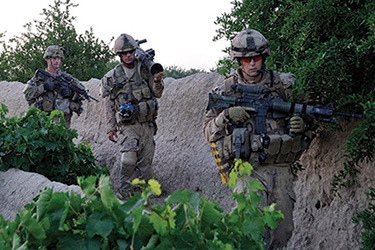
Credit: DND photo AR2011-0200-04 by Corporal Tina Gillies
Soldiers on operations, Afghanistan
Assessing and Managing Ethical Risk in Defence
by J. Peter Bradley and Shaun P. Tymchuk
For more information on accessing this file, please visit our help page.
Lieutenant-Colonel (ret’d) Peter Bradley, CD, PhD, teaches psychology and ethics at the Royal Military College of Canada. Lieutenant-Colonel (ret’d) Shaun Tymchuk, CD, MA, is an infantry officer with extensive experience in operations and training, and a graduate of RMC’s War Studies Program.
Introduction
In recent years, the Canadian Armed Forces (CAF) experienced a number of highly publicized cases of wrongdoing, ranging in severity from neglect of professional duties, to murder.1 While these episodes varied in the extent to which transgressors violated accepted standards of behaviour, the misconduct was destructive on many levels, causing grievous harm to victims, tarnishing the reputation of the Department of National Defence (DND) and the CAF, and diverting resources from other important work. Together, these transgressions and others like them indicate that DND and the CAF can expect violations of this nature to occur again in the future.
Recognizing that DND and the CAF, like all human systems, will experience ethical failures at times, the aim of this article is to raise awareness about ethical risk analysis, the process by which defence leaders can assess their organization’s vulnerability to wrongdoing and to respond appropriately when misconduct occurs. We will commence this work by showing why it is important for members of the defence community (service members and civilians alike) to behave ethically. Second, we explain what we mean by the term ‘ethical risk.’ Third, we provide some thoughts on managing ethical risk. Fourth, we outline a process for assessing ethical risk. Fifth, we close with some recommendations on how DND and the CAF can protect themselves from the harmful consequences of ethical failure.
The Importance of Ethical Behaviour
There are at least six reasons why military personnel and defence employees should behave ethically. First, Canadian law and the international law of armed conflict require it. Second, unethical behaviour by members can seriously damage the credibility of the military institution at home and erode vital public support, as we saw in the case of the Canadian Airborne Regiment in Somalia.2 Third, ethical misbehaviour by even a few individuals at the tactical level can result in mission failure at the strategic level. For example, the guards and interrogators who tortured detainees at the Abu Ghraib prison in Iraq became known in the United States defence community as “…the six guys who lost us the war.”3 Fourth, Canada’s success in military missions requires that its forces work well with allied forces and local people in operational theatres. Unethical behaviour by military personnel can undermine these relationships, jeopardize operational outcomes, and damage the international reputation of the CAF and the nation. For example, when Sub-Lieutenant Jeffrey Delisle was convicted in 2013 of selling secrets to the Russians, some commentators suggested his transgressions might make allies reluctant to share intelligence with Canada in the future.4 Fifth, some types of unethical behaviour, like theft and waste, can be very expensive. Finally, moral distress and psychological injury can incapacitate soldiers who participate in or even witness ethical violations.5
“The CAF does not have an official definition of ‘ethical risk,’ but it has two definitions of ‘risk.’”
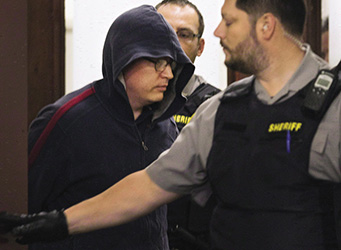
Credit: Canadian Press CP 03987786 by Andrew Vaughan
Sub-Lieutenant Jeffrey Delisle.
Defining Ethical Risk
The CAF does not have an official definition of ’ethical risk,’ but it has two definitions of ’risk.’ The first describes risk as “any circumstance which exposes a decision maker or course of action to some hazard which may produce either a negative effect or else prevent or impede the attainment of one or more objectives.”6 The second defines risk as “…a possible loss or negative mission impact stated in terms of probability and severity.”7
Building upon these definitions of generalized risk, our definition of ethical risk has four parts: (1) ethical risk manifests in the form of a wrongdoing, which has ethical, moral, or legal overtones; (2) the wrongdoing is caused (intentionally or not) by agents of the military, namely anyone working for the military, whether they are soldiers, sailors, or air personnel in uniform, civilian employees of the military, or contractors who may have been temporarily hired for specific missions; (3) the wrongdoing has the potential to impact negatively on the force’s ability to perform its mission, and by mission, we mean the full range of military activities conducted in operations, training, or in garrison; and (4) ethical risk can be reduced before the wrongdoing occurs and mitigated, to some extent, thereafter.
Table 1
Types of Wrongdoing9
|
Wrongdoing Type |
Specific Examples |
|---|---|
|
Stealing |
Stealing funds Stealing property, materiel Accepting favours, bribes, kickbacks Giving unfair advantage to contractors Abuse of office |
|
Waste |
Managing a program badly Wasting organizational assets |
|
Mismanagement |
Covering up poor performance Making false reports or projections of performance |
|
Safety violations |
Using unsafe or non-compliant products Unsafe working conditions |
|
Sexual harassment |
Unwelcome sexual advances Requests for sexual favours Verbal or physical contact of a sexual nature |
|
Unfair discrimination |
Discrimination based on factors that are not job related, including freedoms from discrimination protected by The Canadian Charter of Rights and Freedoms (i.e., race, sex, religion)8 |
|
Violations of the law |
Laws of war Rules of engagement Queen’s Regulations and Orders Relevant military regulations |
|
Other ethics violations |
Misconduct which violates professional military standards, but is not covered by the other categories (i.e., rampant careerism). |
We recognize that wrongdoing is a broad concept, and therefore list in Table 1 a range of unethical, immoral, and illegal behaviour that defence leaders might encounter in their units.
Managing Ethical Risk
Managing ethical risk is about anticipating, preventing, mitigating, and surviving ethical failures.10 Consequently, an effective ethical risk management program should focus upon preventing ethical failures before they happen, and responding to misbehaviour after it has occurred.
Preventing Ethical Violations
The military has several tools at its disposal for preventing transgressions, including ethics (professional), codes and regulations, selection, training, and socialization.
Codes. DND and the CAF jointly endorse a code of values and ethics,11 and the CAF has a code of conduct.12 For the Canadian Army, Duty with Discernment, goes beyond the above-mentioned codes to describe in detail the ethical obligations of “ethical warriors” in operations.13
While most organizations have an ethics code or a similar list of encouraged (or prohibited) behaviours, there is some doubt about the effectiveness of these codes. They are less effective in organizations where the behaviours needed to survive in the organization differ from those espoused in the code.14 That said, there is evidence that codes can have an effect.15
Enforcing codes and regulations. Organizations are usually more adept at punishing unethical behaviour than rewarding ethical behaviour. Because the CAF has many mechanisms in place for rewarding exemplary actions, it could easily find a way to acknowledge exceptionally ethical behaviour. One possibility is to establish an honour like the Golden Whistle Award presented by the Ottawa-based discussion group, “Peace, Order and Good Government.”16
Recruiting and selection. Unethical behaviour could be prevented to some degree by strengthening CAF selection standards, but the gains in this area would be minor, and screening procedures at CAF recruiting centres are already lengthy.
Ethics training. Most Western nations provide ethics instruction to their military personnel, 17 but there is little evidence that such instruction is effective. To date, there has been only one published study on the effectiveness of military ethics training, and the results were positive. Using scripted instructional materials and movie vignettes, leaders in a U.S. Army Stryker Brigade in Iraq delivered battlefield ethics training to 3500 of the brigade’s soldiers. After the training, a smaller group of soldiers completed a survey from which researchers determined that the instruction had contributed to lower levels of battlefield ethics violations, and increased willingness to report wrongdoing.18
Some researchers have suggested that ethics instruction is more effective when it is included within professional training rather than taught as separate courses. Providing ethics training in the form of stand-alone courses delivered by civilian experts or others from outside the professional community will simply reinforce the notion that ethics is not a core military competency. Conversely, having it taught by organizational leaders will demonstrate that ethics is an integral element of military operations.
Socialization. While soldiers can learn a great amount from formal training sessions, one should not underestimate the impact of informal, vicarious learning. Research has shown that the ethical attitudes and behaviour of individuals are shaped by co-workers and immediate supervisors,19 a point which is regularly reinforced in military literature. A case in point is the inspirational leadership and outstanding moral example provided by Air Commodore Leonard Birchall during three-and-a-half years of confinement in Japanese prisoner of war camps during the Second World War.20
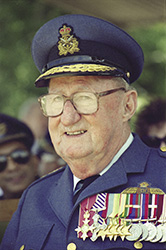
Credit: DND photo ISC-95-302 04/95
Air Commodore Leonard Birchall, CM, OBE, DFC, CD, a true Canadian hero by any measure.
Responding to Ethical Violations
When organizations experience a serious ethical violation, they must respond in ways that will preserve their ethical integrity and reputation, demonstrate that unethical conduct is not tolerated, minimize the costs of the unethical actions, restore the damage done, and provide assistance to the victims and perpetrators.21 The organizational response to ethical wrongdoing will be most effective when it is based upon the following principles:
Understanding and learning. Investigations of ethical misconduct fundamentally seek to understand the root causes of ethical risk within the organization, so that effective remediation can occur. The completed investigation should inform decision making on any remedial action required. Stripped of personal detail, the results should also be shared extensively to demonstrate commitment to ethical performance and compliance, and to further ethics training and education.
Communication. Proactive and candid communication with both internal and external audiences is essential when serious ethical breaches come to light.22 Military personnel and the Canadian public expect senior leaders, as stewards of the military profession, to speak for the institution in dire situations, and to do so in an honest and forthright manner. Anything less will fail to satisfy the inevitable thirst for information, and risk further damage to the reputation of the organization.23
For an excellent example of messaging in response to ethics violations, readers should view the video of Lieutenant-General David Morrison, Chief of Army in Australia, speaking out against alleged sexual misconduct by some soldiers and officers. Carried first on internal military media and then public Australian media, his message was unequivocal: Such behaviour is inconsistent with Australian values, and “… those who think that it is OK to behave in a way that demeans or exploits their colleagues have no place in this army.”24
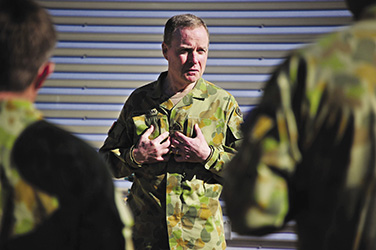
Credit: Australian Defence Image Library 20130704adf8118679_070 by Lee-Anne Mack
Lieutenant-General David Morrison, AO, Chief of Army, Australia
Punishment. Prompt and fair sanctions must be the inescapable consequence of serious violations of an organization’s ethical code of conduct.25 Accordingly, The DND and CF Code of Values and Ethics states that CAF members who fail in their ethical obligations may be subject to change of duties, disciplinary action under the National Defence Act, or administrative action including release from the CAF.26 Consequently, when sentencing Captain Semrau following his conviction on the charge of disgraceful conduct, the presiding military judge stated that it was necessary to send a clear message to all concerned that such behaviour is unacceptable, and it will not be tolerated.27
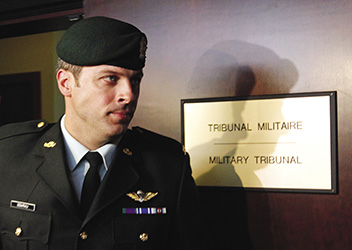
Credit: Reuters RTR2GJQP by Chris Wattie
Captain Robert Semrau
Assessing Ethical Risk
The idea behind ethical risk analysis is to identify threats and vulnerabilities before they lead to ethical failure, so that they can be eliminated or their severity of impact reduced. Unfortunately, ethical risk analysis may not be well understood in the defence community. Chief of the Defence Staff Guidance to Commanding Officers directs commanding officers (COs) to manage ethical risk, but it does not provide any advice on how to accomplish it.28 The Army Ethics Program (AEP) recommends that COs assess unit ethical risk prior to assuming command, after taking command, and when warned for an operational mission; however, the methods suggested for this do not make use of established CAF operational planning and operational risk management procedures.29 This apparent gap between precept and process might cause some commanders to overlook ethical risk analysis in their unit mission planning, or to treat it as a lower priority activity. There is clearly a need to incorporate ethical risk in CAF doctrine and procedures for operational planning and operational risk management, but that is a subject for another article. For the present, we will provide some practical suggestions on how to assess ethical risk. Essentially, ethical risk analysis involves two steps: considering where the threats are, and gathering hard data, from surveys and other measures, to confirm the extent of potential risks.
A Conceptual Framework for Analysing Ethical Risk
Ethical risks are context-dependent, meaning that they will vary according to environmental characteristics like geography, type of work one is engaged in and such. For example, many of the ethical threats facing military personnel who work in logistics are different than those facing medical staff and personnel in other occupations. At the same time, there are threats and vulnerabilities which are ubiquitous, such as the influence of charismatic, immoral peers and leaders.
We recommend analysing ethical threats and vulnerabilities at three levels—the environment, the organization, and the individual—in order to consider all potential risks. There are unique risks at each of these levels, but some risks spill over to other levels, manifesting themselves in slightly different ways, depending upon the level observed.
The environment. Many of the environmental factors which influence ethical attitudes are based in the social and political norms that shape society. These social and political influences are pervasive and often subtle, so much so that individuals are often unaware of their impact.
The fortunes of political leaders in democratic nations turn on the support they receive from their electorate, so they tend to emphasize the positive and downplay the negative, a practice which is apparent to all, but especially so for government officials and military officers who work at senior levels. One potentially harmful consequence of this influence can be reluctance of some senior leaders to communicate frankly about defence matters. (We are not talking here about military secrets which should be kept from potential enemies.) High-level decisions impact on many stakeholders, and sometimes, there are strong pressures to act in a particular way that will benefit some stakeholders over others. Transparency ensures that decision makers will consider the implications for all who may be affected. But when there is a lack of transparency, decision makers are more susceptible to decision-making errors like justification, self-deception, and ‘groupthink,’ and are more likely to choose options which are ethically flawed. For more specifics on this issue, see Professor Stephen Saideman’s article in which he criticizes DND for a lack of openness and a habit of denying the existence of problems.30
“The fortunes of political leaders in democratic nations turn on the support they receive from their electorate…”
Another environmental level risk stems from the desire within the political-military sphere to minimize the danger facing one’s soldiers in operations. In the Western World, this has led to what Martin Shaw calls risk-transfer war, a style of fighting which relies upon precision weapons and media management.31 Employing precision weapons transfers the risk of personal injury and death from one’s own soldiers to enemy combatants and non-combatants, but it can also lead to the disproportionate and indiscriminate use of force (a violation of just war principles and international law). Managing the media has its own ethical risk, particularly when officials withhold information which should be reported.
In addition to the social and political influences described above, there is also the experience of combat itself, because in the words of Chris Hedges, former war correspondent and author, “…war exposes the capacity of evil that lurks not far below the surface within all of us.”32 Soldiers in combat can experience such intense pressure that some of them may lose their moral compass and commit horrible acts. Indeed, several recent studies provide empirical evidence that combat exposure can lead to ethical wrongdoing.33
The organization. The culture of an organization, if it is ethically challenged, can lead unit members to commit ethics violations. (Organizational culture refers to the spirit of an organization and the values and beliefs shared by its members.)34 Four aspects of an organization’s culture can lead its members to either engage in sound ethical behaviour or unethical actions.35 First, there are the norms, which are rules within an organization, many of them informal and not written down, that guide the social behaviour of unit members. As an example, a unit that prides itself on getting the job done at all costs may inadvertently encourage its members to bend or break rules for wrong reasons. Second are the unit’s leaders, those who have the ability to influence the perceptions and actions of other unit members? Informal and lower-level unit leaders are important here, because research has shown that “…it is co-workers and immediate supervisors, not distant executives, who often serve as role models for ethical behaviour at work.”36 Third is the extent to which unit members obey authority figures and comply with unit regulations. Responsible obedience is required here, not blind obedience, because passive subordinates conforming to or colluding with bad leaders can create unethical units.37 The best units, from an ethical perspective, consist of unit leaders with high moral principles who would never encourage their subordinates to engage in unethical actions, and responsible followers who can distinguish lawful direction from unlawful direction and have the moral courage to resist the latter. Fourth relates to the extent to which a unit holds its members accountable for their actions. Those units which promote accountability are more likely to have members who behave ethically than units which fail to punish unethical behaviour or neglect to reward morally superior actions. For a practical example of how these four elements of organizational culture can lead to unethical consequences in a military unit, the ethical failings of the Canadian Airborne Regiment in Somalia in 1993 is an instructive case.38
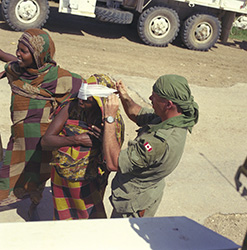
Credit: DND photo HSC92-0849-300
Helping in Somalia, 1992.
Careerism is an ethical threat. It thrives in the military because most individuals wish to be promoted, but it is a two-edged sword. On the positive side, the prospect of promotion can encourage people to work hard and to seek greater responsibility, thereby contributing to the organization. But careerism can also entice individuals to avoid their professional responsibilities by playing it safe, creating no waves, and being ‘politically correct.’39 At its worst, careerism can also lead subordinates to curry favour with their superiors by engaging in unethical behaviour, such as complying with ethically ambiguous orders, keeping problems quiet, failing to voice dissent when a situation calls for it, and basically ‘going along’ to get ahead.40 The Report of the Somalia Inquiry gives a thorough account of careerist behaviours related to the selection and screening of personnel for the Canadian Airborne Regiment, actions which no doubt contributed to the Regiment’s ethical failures in Somalia.41
Competition among individuals, units, or organizations that is not kept in check can result in an unhealthy lack of cooperation, which, in turn, can lead to neglect of some stakeholders’ interests and ultimately cause ethical failures. On reading about the disagreement around the proper management of detainees in Afghanistan,42 one wonders if competition between military officers and officials from other components of Canada’s Afghanistan effort may have contributed in some way to the development of unsatisfactory detainee handling procedures, which resulted in scandal.
Military leaders cannot take corrective action if they do not know what needs to be fixed, so an important aspect of a unit’s ethical culture is the effectiveness of the unit’s system for reporting ethical failures to the chain of command. Usually, there are few problems in this area if the misconduct is witnessed by a leader, but it is less certain that a member who is not in a leadership position will report any misconduct he or she observes. Given that an important function of the Canadian military ethos is to “create and shape the desired military culture of the Canadian Forces,”43 the CAF may have difficulty building a desirable culture if a sizeable portion of its unprofessional behaviour goes unreported. This is where internal ‘whistle-blowing’ mechanisms, such as the Army’s Lamplighter program, can play an important role.44 But such mechanisms will only be effective if members report infractions, leaders take action, and members recognize that the system is working.
CAF leadership doctrine states that the institution must be a learning organization, one that openly encourages the debate of new ideas, critically examines its successes and failures on an ongoing basis, and learns from experience.45 The Canadian Public Service values the “self-reflective” learning organization for its ability to challenge its basic assumptions about how results are achieved, openly discuss its weaknesses, and courageously correct itself.46 Although CAF leadership doctrine does not emphasize the link between organizational learning and ethics, this theme is explicit in the Government of Canada’s Management Accountability Framework.47 Regrettably, there are several recent indicators which suggest that DND and the CAF may be falling short of learning organization norms.
The first is the recent decision to discontinue the Officer Professional Military Education Program (OPME).48 OPME consisted of a half-dozen courses (one of which was a university level course in leadership and ethics), which junior officers had to complete to advance in rank, but were also taken by many others for personal development. The details of the new program have yet to be published, but early indications suggest the replacement program will fall short of the learning organization standard for ethics.
The second is the lack of opportunities for defence personnel to engage in public dialogue on ethics issues. DND and the CAF held about a half-dozen annual ethics conferences—called the Canadian Conference on Ethical Leadership—between 1996 and 2006, but they were discontinued. Similarly, an ethics symposium for general officers ran for several years in the early-2000s, but this activity appears to have ceased as well. On a more encouraging note, the Army recently collaborated with Queen’s University to host a conference on the subject of ethical warriors in June 2013.49
The individual. While the environmental and organizational influences can seem abstract and their impact difficult to determine with certainty, they ultimately manifest themselves in the concrete actions of individuals where they are directly observable. The success or failure of military units depends upon the actions of its members, and, as previously mentioned, any system relying upon human performance is bound to have failures (as we so frequently observe in newspaper reports and newscasts).
At the individual level of analysis, ethical risks appear in the form of cognitive, motivational, and physical limitations of individual military members. For greater precision in analyzing these limitations, we can view ethical competence as consisting of four components: moral awareness, moral judgment, moral motivation, and moral action.50 Individuals with low levels of moral awareness are less able to perceive the ethical demands of a particular event, hence they may not know what to do,51 and are therefore more likely to make unethical choices. Moral judgment refers to the ability to reason through the moral implications of a particular situation to identify the most moral course of action. According to Kohlberg, an early researcher in this field,52 some individuals at the lower end of the moral development scale will decide what is right on the basis of self-interest. Most adults operate a little higher on the scale, making decisions on the basis of normative influences, such as rules, regulations, and the opinions of others (most military personnel function at this level). A smaller group performs at the highest level of moral judgment and makes their moral choices on the basis of ethical principles. Judgment is related to intelligence, and like awareness, it can be improved with education and training. Moral motivation is like moral courage or will, so morally motivated individuals are able to subordinate their self-interest to higher-order ideals. Moral action refers to the ability to bring the three moral components of awareness, judgment, and motivation together to perform an observable, ethical act.
Three points warrant emphasis here. First, all four of the above-mentioned moral components can be viewed as abilities, so some people will be stronger in these capacities than others. Second, research has shown that moral awareness and judgment are most responsive to ethics instruction, but there are also a few studies showing that actual behaviour can be improved with moral training.53 It is still not known how best to raise levels of moral motivation, but training may also help here, along with strong ethical examples gleaned from unit peers and leaders. Third, all of these moral competencies are vulnerable to decision-making errors and biases, so training sessions should devote some time to instructing individuals how to avoid mistakes in their decision making.
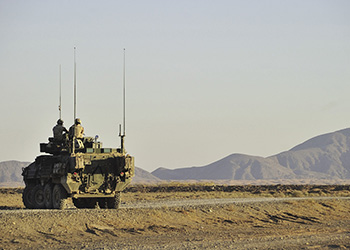
Credit: DND photo AR2011-0487-011 by Master Corporal Dan Shouinard
Soldiers on operations, Afghanistan
In addition to the moral capacities discussed above, personal disposition, attitudes, mood, and emotion can also influence ethical functioning. Individuals who are low on empathy are more likely to overlook the interests of others, and more likely to participate in harmful acts against others.54 This is a potential problem in cohesive military units, where it is not uncommon to disdain members of out-groups. What may start as simple dismissal or rejection of an out-group can escalate into abuse in the absence of strong discipline or leadership. Ego strength is a strong antidote to unethical influences,55 because it enables individuals to self-regulate and to resist harmful impulses. Fortunately, ego strength can be strengthened with training and experience. Locus of control also has an impact upon moral behaviour.56 Individuals with an external locus of control believe that what they do will have little impact upon eventual outcomes, so they are more susceptible to unethical influences than individuals with an internal locus of control who believe that their actions can affect outcomes in some way. Leaders need to recognize that it is relatively easy for subordinates to adopt an external locus of control, particularly if they think their efforts are insignificant and have little impact upon the organization’s performance. Ethics training can address this by requiring everyone to take responsibility for the organization’s professional reputation.
Studies show that some job-related attitudes are associated with organizational misbehaviour. In particular, individuals who are dissatisfied with their jobs and/or have low levels of commitment to their organization are more likely to engage in workplace misconduct.57 We also know, both from academic studies and from practical military experiences such as the My Lai massacre in 196858 and the Somalia scandal in 1993,59 that emotions like anger and frustration can lead soldiers to engage in immoral behaviour.
“A number of measures have been developed for use in evaluating ethical risk, but most are owned by private firms and are only available to clients who purchase them.”
Measuring Ethical Risk with Surveys
A number of measures have been developed for use in evaluating ethical risk, but most are owned by private firms and are only available to clients who purchase them. Fortunately, there are a number of tools within DND and the CAF which, with some minor revisions, could be used in assessing ethical risk. These are the Defence Ethics Program surveys,60 the Human Dimensions of Operations surveys,61 and three surveys originally developed for evaluating the AEP.62 Another source of information which could be useful in ethical risk analysis is the Annual Report of the Judge Advocate General to the Minister of National Defence on the Administration of Military Justice in the Canadian Forces, which gives an overview of the summary trials and courts martial conducted in the CAF.63
Recommendations
- Integrate ethics into regular practices. Ethics needs to be viewed as integral to military operations and a matter of importance to leaders, supervisors, and commanders, not a discretionary activity managed by staff or ethics experts.
- Incorporate ethics training into professional training. Ethics instruction should be embedded within unit training, professional development activities, and career (i.e., leadership) courses to underscore ethics as a vital aspect of all defence work. Ethics training should rarely occur as a distinct, stand-alone activity.
- Develop ethics training materials for unit leaders. Instructional materials should be developed by ethics experts for unit ethics training (i.e., scenarios, instructor notes, and presentations) and made available to everyone by placing these materials on the DEP website or other DND/CAF websites.
- Encourage leaders to be ethical role models. Serving as an ethical role model for one’s subordinates should be recognized as an important part of the leader’s job, reinforced in leadership training, and assessed in performance evaluation reports.
- Include ethical risk analysis in operational planning doctrine and training. Ethical risk analysis should be an integral element of the CAF operational planning process (OPP) and operational planning doctrine should be revised to give direction on how to consider ethical factors in OPP. Similarly, ethical risk management should be an integral element of the CAF operational risk management process, and should be covered in operational risk management doctrine.
- Employ surveys in ethical risk assessment. Surveys currently used to measure ethics issues, like the DEP, HDO, and AEP surveys, should be reviewed and revised where practicable to make them more useful in assessing ethical risk. If necessary, new surveys should be developed to gather information on ethical threats and vulnerabilities.
- Poll service members on ethical risks. DND employees and service members are a valuable source of information on ethical risk, and they should be canvassed to provide examples of ethical threats and vulnerabilities they have witnessed.
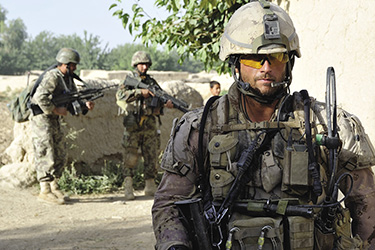
Credit: DND photo AR2011-0200-36 by Corporal Tina Gillies
Soldiers on operations, Afghanistan
Notes
- David Pugliese, “Sex abuse and silence exposed,” in the Ottawa Citizen, 21 September 2009, at http://www.ottawacitizen.com/news/abuse+silence
+exposed/2010032/story.html. “Canada wanted Afghan prisoners tortured: lawyer,” CBC News, 5 March 2010, at http://www.cbc.ca/news/canada/story/2010/03/05/afghan-attaran005.html. Michael Friscolanti, “A soldier’s choice,” in Maclean’s Magazine, 24 May 2010, pp. 20-25. Rene Bruemmer, “Revelation of Affair Ruined his Life: Disgraced General,” in Postmedia News, 21 July 2011, at http://news.nationalpost.com/2011/07/21/life-ruined-by-affair-disclosure-disgraced-general/ . “Col. Russell Williams pleads guilty to all 88 charges,” CBC News, 21 October 2010, at http://www.cbc.ca/news/canada/story/2010/10/18/col-williams-court-1018.html. - Lieutenant-Colonel Bernd Horn, Bastard Sons: An Examination of Canada’s Airborne Experience 1942-1995 (St Catherines, ON: Vanwell Publishing, 2001), pp. 197-201. Report of the Commission of Inquiry into the Deployment of Canadian Forces to Somalia, Dishonoured Legacy: The Lessons of the Somalia Affair (Ottawa: Canadian Government Publishing, 1997), ES-45/ES-46.
- Dominic Streatfeild, Brainwash: The Secret History of Mind Control (New York: Thomas Dunne Books, 2007), p. 378.
- Murray Brewster, “Jeffrey Delisle, Navy Spy, Removed From Canadian Military,” Canadian Press, 13 February 2013, at http://www.huffingtonpost.ca/2013/02/13/jeffrey-delisle-spy-removed-canadian-military_n_2680436.html.
- Shira Maguen and Brett Litz, Moral Injury in the Context of War, undated at <http://www.ptsd.va.gov/professional/pages/moral_injury_at_war.asp.>.
- Leadership in the Canadian Forces: Conceptual Foundations (Kingston, ON: Canadian Defence Academy Press, 2005), p. 132.
- Risk management for CF operations, Joint Doctrine Manual B-GJ-005-502/FP-000 (2007), pp. 1-2.
- The Canadian Charter of Rights and Freedoms, at http://publications.gc.ca/collections/Collection/CH37-4-3-2002E.pdf.
- Table 1 is adapted from Near, Rehg, Van Scotter and Miceli, “Does Type of Wrongdoing Affect the Whistle-Blowing Process?” in Business Ethics Quarterly 14 (2004), pp. 226-227.
- Robert C. Chandler, “Avoiding Ethical Misconduct Disasters,” in Graziadio Business Review, 8 (3), (2005), at http://gbr.pepperdine.edu/?p=2314.
- DND and CF Code of Values and Ethics, 18 July 2012, at http://www.dep.forces.gc.ca/dep-ped/code/code-eng.aspx.
- Code of Conduct for CF Personnel (B-GG-005-027/AF-023) undated, at http://www.forces.gc.ca/jag/publications/oplaw-loiop/cfcc-ccfc-eng.pdf.
- Richard J. Walker, Duty with Discernment: CLS Guidance on Ethics in Operations, Strategic Edition (Ottawa: Directorate of Army Public Affairs, September 2009), (B-GL-347-001/FP-000), pp. 5-6.
- John Dobson, “Why Ethics Codes Don’t Work,” in Financial Analysts Journal, 59(6), (2003), p. 33.
- LRN (formerly Legal Research Network), “The impact of codes of conduct on corporate culture,” 2006, at <http://www.ethics.org/files/u5/LRNImpactofCodesofConduct.pdf >. L.K. Treviño, G.R. Weaver, and S. Reynolds, “Behavioural Ethics in Organizations: A Review,” in Journal of Management, 32(6), (2006), pp. 951-990.
- See the web site of Canadians for Accountability, at <http://canadians4accountability.org/golden-whistle-award/#2012>.
- Paul Robinson, Nigel de Lee, and Don Carrick (eds), Ethics Education in the Military (Aldershot, Hampshire, UK: Ashgate, 2008).
- C.H. Warner, G.N. Appenzeller, A. Mobbs, J.R. Parker, C.M. Warner, T. Grieger and C.W. Hoge, “Effectiveness of battlefield-ethics training during combat deployment: a programme assessment,” in The Lancet, pp. 378, 915-924.
- G.R Weaver, L.K. Trevino and B. Agle, “Somebody I look Up To: Ethical Role Models in Organizations,” in Organizational Dynamics, 34 (4), (2005), p. 314.
- “Leadership,” in The Canadian Air Force Journal, Winter 2009, Vol 2, No 1, pp. 28-40.
- Chandler, pp. 2, 5.
- O.C. Ferrell and Linda Ferrell, “Ethical Disaster Recovery Model for Marketing,” online abstract, at http://www.sbaer.uca.edu/research/mma/2003/papers/30.pdf. Chandler, p. 2.
- LRN, “Ethics and compliance risk management: Improving business performance and fostering a strong ethical culture through a sustainable
process,” p. 9, at. http://www.ethics.org/files/u5/LRNRiskManagement.pdf. - Rachel Olding, “Unlikely feminist hero: Army chief’s video message draws plaudits, The Age,
14 June 2013, at http://www.theage.com.au/opinion/political-news/unlikely-feminist-hero-army-chiefs-video-message-draws-plaudits-20130614-2o86b.html - Chandler, pp. 7-8.
- DND and CF Code of Values and Ethics, Paragraph 7.
- R. v. Semrau, 2010 CM 4010, Reasons for Sentence, para 52, at http://www.jmc-cmj.forces.gc.ca/assets/CMJ_Internet/docs/en/2010cm4010.pdf.
- CDS Guidance to COs, Chapter 3 - “Defence Ethics and Senior Leadership,” para 302.2, at http://www.army.forces.gc.ca/land-terre/aep-peat/lfco-ocft/annexa-eng.asp. (Annex A to Land Force Command Order (LFCO) 21-18, Army Ethics Program (AEP)).
- AEP para 5.b (3), Annex B (Supplement to Chapter 3 of CDS Guidance to COs: Commanding Officer’s Unit Ethics Plan), paras S-304.4, S-305.2, S-305.7, S-307.1, at http://www.army.forces.gc.ca/land-terre/aep-peat/lfco-ocft/annexb-eng.asp.
- Stephen Saideman, “The Canadian Forces have a dangerous habit of denial,” in The Globe and Mail, 15 January 2013, at http://www.theglobeandmail.com/commentary/the-canadian-forces-have-a-dangerous-habit-of-denial/article7353925/.
- Martin Shaw, The New Western Way of War: Risk-Transfer War and its Crisis in Iraq, (Cambridge, UK: Polity Press, 2005), pp. 1-2.
- Chris Hedges, War Is a Force That Gives Us Meaning (New York: Anchor Books, 2002), p. 3.
- J.E. Wilk, P.D. Bliese, J.L. Thomas, M.D. Wood, D. McGurk, C.A. Castro, and C.W. Hoge, “Unethical Battlefield Conduct Reported by Soldiers Serving in the Iraq War,” in The Journal of Nervous and Mental Disease, 201 (4) (2013), pp. 259-265.
- Linda Klebe Trevino, “Ethical Decision Making in Organizations: A Person-Situation Interactionist Model,” in Academy of Management Review Vol. 11, No. 3 (1986), p. 611.
- Ibid.
- Weaver, Trevino, and Agle, p. 314.
- Art Padilla, Robert Hogan, and Robert B. Kaiser, “The Toxic Triangle: Destructive Leaders, Susceptible Followers, and Conducive Environments,” in The Leadership Quarterly, 18, (2007), pp. 182-183.
- J.P. Bradley, “Why People Make the Wrong Choices: The Psychology of Ethical Failure,” in Th.A. van Baarda and D.E.M. Verweij (eds), The Moral Dimension of Asymmetrical Warfare: Counter-Terrorism, Democratic Values and Military Ethics (Leiden, Netherlands: Martinus Nijhoff Publishers, 2009), pp. 217-311.
- G.I. Wilson, “Careerism,” in Winslow T. Wheeler (ed), The Pentagon Labyrinth: 10 Short Essays to Help You Through It (Washington D.C.: Center for Defense Information, 2011), pp. 44-45, at http://dnipogo.org/labyrinth/.
- Ibid, p. 54. See also, Chris Hedges, “The Careerists,” posted on Truthdig, 23 July 2012, at <http://www.truthdig.com/report/item/the_careerists_20120723/>, and Lecture at the U.S. Military Academy by Secretary of Defense Robert M. Gates, 21 April 2008, at http://www.defense.gov/speeches/speech.aspx?speechid=1233.
- Report of the Commission of Inquiry into the Deployment of Canadian Forces to Somalia,
pp. 501-541. - Janice Gross Stein and Eugene Lang, The Unexpected War: Canada in Kandahar (Toronto: Viking, 2007), pp. 246-258; Murray Brewster, The Savage War: The Untold Battles of Afghanistan (Mississauga, ON: John Wiley and Sons, 2011), pp. 63-68.
- Duty with Honour, p. 26.
- See the AEP, Appendix 2: A soldier’s primer on military ethics, at http://www.army.forces.gc.ca/land-terre/aep-peat/duty-servrir/appendix_2-appendice_2/primer-introduction-eng.asp.
- Duty with Honour, p. 68; Conceptual Foundations, pp. 93, 131; Leadership in the Canadian Forces: Doctrine, pp. 13, 31.
- See “A Primer on the Learning Organization,” February 2007, at http://www.tbs-sct.gc.ca/dev/dwnld/lapn-eng.pdf.
- Treasury Board of Canada Secretariat, “Management Accountability Framework,” at http://www.tbs-sct.gc.ca/maf-crg/overview-apercu/elements-eng.asp.
- According to internal CAF communication dated 1 November 2012, the OPME Program will cease to be delivered on 30 April 2013. (Para 2 of Canadian Forces General (CANFORGEN) message 218/12, dated 011212Z November 2012).
- Kingston Conference on International Security 2013: Ethical Warriors: The Profession of Arms in Contemporary Perspective, 10-12 June 2013, Kingston, Ontario, at <http://www.queensu.ca/kcis/index.html>.
- D. Narvaez and J.R. Rest, “The Four Components of Acting Morally,” in W.M. Kurtines and J.L. Gewertz (eds.), Moral Development: An Introduction (Boston, MA: Allyn and Bacon, 1995).
- Marilyn B. Hollar, “Risk Management Ethics,” in Rough Notes (August 2004), at <http://www.roughnotes.com/rnmagazine/08cdindex04.htm>.
- Lawrence Kohlberg, “Moral Stages and Moralization: The Cognitive-Developmental Approach,” in T Lickona (ed.), Moral Development and Behavior: Theory, Research and Social Issues (New York: Holt, Rinehart, and Winston, 1976), pp. 34-35.
- E.P. Waples, A.L. Antes, S.T. Murphy, S. Connelly and M.D. Mumford, “A Meta-Analytic Investigation of Business Ethics Instruction,” in Journal of Business Ethics, 87 (2008), p. 139.
- N. Eisenberg, “Emotion, regulation, and moral development,” in Annual Review of Psychology, 51 (2000), pp. 665-697.
- Trevino, p. 609.
- A. Forte, “Locus of control and the moral reasoning of managers,” in Journal of Business Ethics, 58 (2005), pp. 65-77.
- Vardi and Weitz, p. 133.
- Michael Bilton and Kevin Sim, Four hours in My Lai (London: Viking, 1992).
- Horn, p. 197.
- D.L. Messervey, G.T. Howell, T. Gou, M. Yelle, 2010 Defence Ethics Survey Report. Defence Research and Development Canada DGMPRA TM 2011-037.
- G. Ivey, S. Blanc, M. Therrien, and H. McCuaig-Edge, “Human Dimensions of Operations Project: Transformation and Impact” (paper presented at the 51st Annual International Military Testing Association conference, Tartu, Estonia, 2-5 November, 2009).
- J.P. Bradley, D.F. O’Keefe, A.T. MacIntyre, J.D Lagacé-Roy, & B.A. Ball, Measuring the Effectiveness of the Army Ethics Program: Army Ethics Program Evaluation Project, Year-end Report for Fiscal Year 2007/08 (Kingston, ON: Royal Military College of Canada, 2008).
- This report is available online at <http://www.forces.gc.ca/jag/publications/index-eng.asp.>
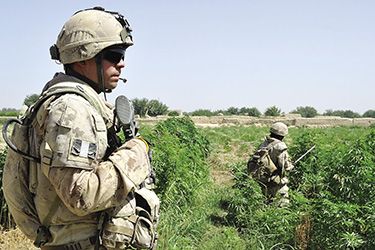
Credit: DND photo AR2011--022-67 by Corporal Tina Gillies
Soldiers on operations, Afghanistan



